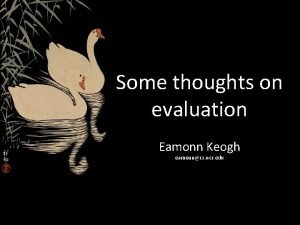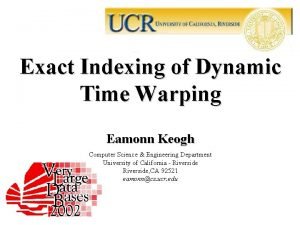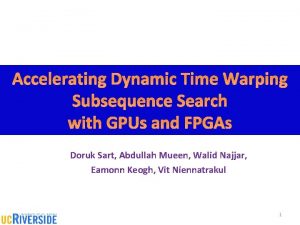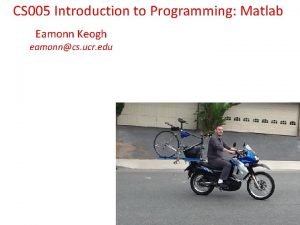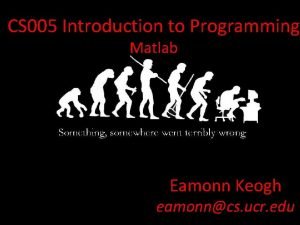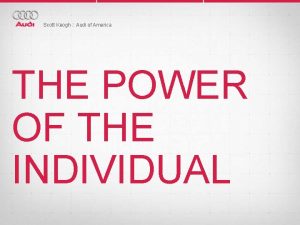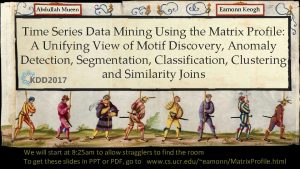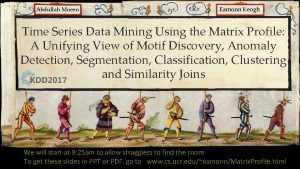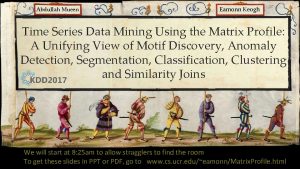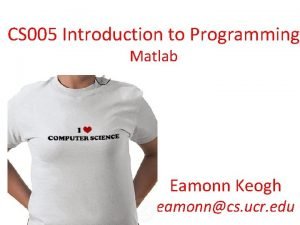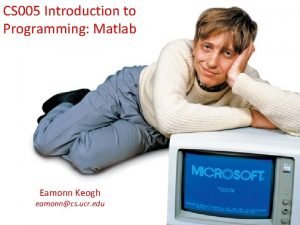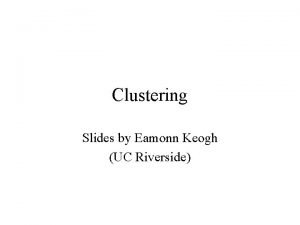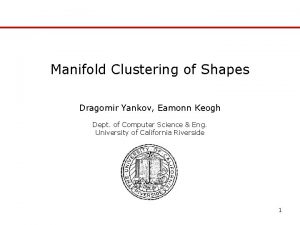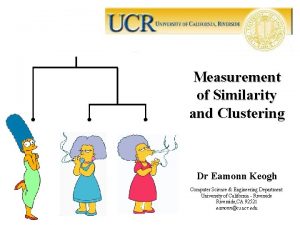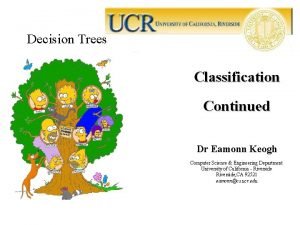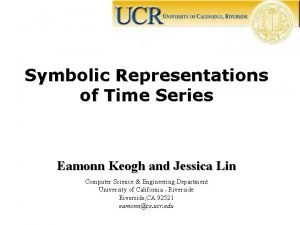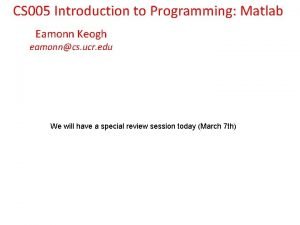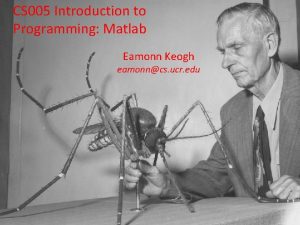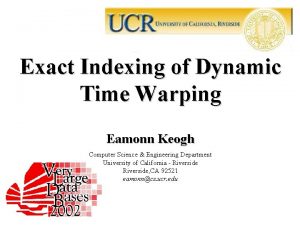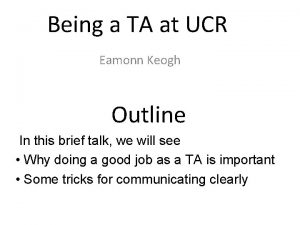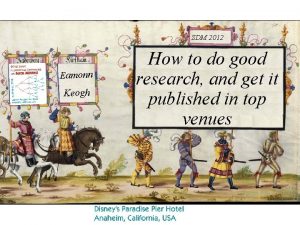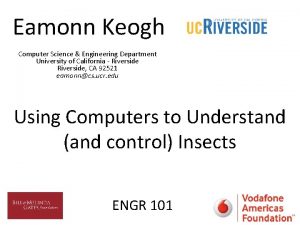Eamonn Keogh Dendrograms for Data Mining What is










































- Slides: 42

Eamonn Keogh Dendrograms for Data Mining

What is Clustering? Also called unsupervised learning, sometimes called classification by statisticians and sorting by psychologists and segmentation by people in marketing • Informally, finding natural groupings or relationships among objects.

What is a natural grouping among these objects?

What is a natural grouping among these objects? Clustering is subjective Simpson's Family School Employees Females Males

Two Types of Clustering • Partitional algorithms: Construct various partitions and then evaluate them by some criterion • Hierarchical algorithms: Create a hierarchical decomposition of the set of objects using some criterion Hierarchical Partitional

What is Similarity? Webster's Dictionary The quality or state of being similar; likeness; resemblance; as, a similarity of features. Similarity is hard to define, but… “We know it when we see it” The real meaning of similarity is a philosophical question. We will take a more pragmatic approach.

Defining Distance Measures Definition: Let O 1 and O 2 be two objects from the universe of possible objects. The distance (dissimilarity) between O 1 and O 2 is a real number denoted by D(O 1, O 2) Peter Piotr 0. 23 3 342. 7

A Useful Tool for Summarizing Similarity Measurements Introducing the dendrogram. {Cladogram, Phylogenetic Tree, phylogram} The similarity between two objects in a dendrogram is represented as the height of the lowest internal node they share.

There is only one dataset that can be perfectly clustered using a hierarchy… (Bovine: 0. 69395, (Spider Monkey 0. 390, (Gibbon: 0. 36079, (Orang: 0. 33636, (Gorilla: 0. 17147, (Chimp: 0. 19268, Human: 0. 11927): 0. 08386): 0. 06124): 0. 15057): 0. 54939);

Note that hierarchies are commonly used to organize information, for example in a web portal. Yahoo’s hierarchy is manually created, we will focus on automatic creation of hierarchies in data mining. Business & Economy B 2 B Finance Aerospace Agriculture… Shopping Banking Bonds… Jobs Animals Apparel Career Workspace

A Demonstration of Hierarchical Clustering using String Edit Distance Pedro (Portuguese) Petros (Greek), Peter (English), Piotr (Polish), Peadar (Irish), Pierre (French), Peder (Danish), Peka (Hawaiian), Pietro (Italian), Piero (Italian Alternative), Petr (Czech), Pyotr (Russian) Cristovao (Portuguese) Christoph (German), Christophe (French), Cristobal (Spanish), Cristoforo (Italian), Kristoffer (Scandinavian), Krystof (Czech), Christopher (English) Miguel (Portuguese) stof fe Kry r stof oro Kri Cri stof an oba l Cri st sde ph Cri Chr isto phe isto er Chr rist oph Pea dar Mic hali s Mic hae l Mig ue Mic l k Cri stov ao Ch a Pek Pio tr Pyo tr Pet ros Pie tro Ped ro Pie rre Pie ro Pet e Ped r er Michalis (Greek), Michael (English), Mick (Irish!)

Pedro (Portuguese/Spanish) Pio tr Pyo tr Pet ros Pie tro Ped ro Pie rre Pie ro Pet er Ped er Pek a Pea dar Petros (Greek), Peter (English), Piotr (Polish), Peadar (Irish), Pierre (French), Peder (Danish), Peka (Hawaiian), Pietro (Italian), Piero (Italian Alternative), Petr (Czech), Pyotr (Russian)

Hierarchal clustering can sometimes show patterns that are meaningless or spurious • For example, in this clustering, the tight grouping of Australia, Anguilla, St. Helena etc is meaningful, since all these countries are former UK colonies. • However the tight grouping of Niger and India is completely spurious, there is no connection between the two. AUSTRALIA St. Helena & Dependencies ANGUILLA South Georgia & South Sandwich Islands U. K. Serbia & Montenegro (Yugoslavia) FRANCE NIGER INDIA IRELAND BRAZIL

• The flag of Niger is orange over white over green, with an orange disc on the central white stripe, symbolizing the sun. The orange stands the Sahara desert, which borders Niger to the north. Green stands for the grassy plains of the south and west and for the River Niger which sustains them. It also stands for fraternity and hope. White generally symbolizes purity and hope. • The Indian flag is a horizontal tricolor in equal proportion of deep saffron on the top, white in the middle and dark green at the bottom. In the center of the white band, there is a wheel in navy blue to indicate the Dharma Chakra, the wheel of law in the Sarnath Lion Capital. This center symbol or the 'CHAKRA' is a symbol dating back to 2 nd century BC. The saffron stands for courage and sacrifice; the white, for purity and truth; the green for growth and auspiciousness. AUSTRALIA St. Helena & Dependencies ANGUILLA South Georgia & South Sandwich Islands U. K. Serbia & Montenegro (Yugoslavia) FRANCE NIGER INDIA IRELAND BRAZIL

We can look at the dendrogram to determine the “correct” number of clusters In this case, the two highly separated subtrees are highly suggestive of two clusters. (Things are rarely this clear cut, unfortunately)

One potential use of a dendrogram is to detect outliers The single isolated branch is suggestive of a data point that is very different to all others Outlier

(How-to) Hierarchical Clustering The number of dendrograms with n leafs = (2 n -3)!/[(2(n -2)) (n -2)!] Number of Leafs 2 3 4 5. . . 10 Number of Possible Dendrograms 1 3 15 105 … 34, 459, 425 Since we cannot test all possible trees we will have to heuristic search of all possible trees. We could do this. . Bottom-Up (agglomerative): Starting with each item in its own cluster, find the best pair to merge into a new cluster. Repeat until all clusters are fused together. Top-Down (divisive): Starting with all the data in a single cluster, consider every possible way to divide the cluster into two. Choose the best division and recursively operate on both sides.

We begin with a distance matrix which contains the distances between every pair of objects in our database. D( , ) = 8 D( , ) = 1 0 8 8 7 0 2 4 0 3 0 7 4 3 1 0

Bottom-Up (agglomerative): Starting with each item in its own cluster, find the best pair to merge into a new cluster. Repeat until all clusters are fused together. Consider all possible merges… … Choose the best

Bottom-Up (agglomerative): Starting with each item in its own cluster, find the best pair to merge into a new cluster. Repeat until all clusters are fused together. Consider all possible merges… … … Choose the best

Bottom-Up (agglomerative): Starting with each item in its own cluster, find the best pair to merge into a new cluster. Repeat until all clusters are fused together. Consider all possible merges… … Choose the best

Bottom-Up (agglomerative): Starting with each item in its own cluster, find the best pair to merge into a new cluster. Repeat until all clusters are fused together. Consider all possible merges… … Choose the best

We know how to measure the distance between two objects, but defining the distance between an object and a cluster, or defining the distance between two clusters is non obvious. • Single linkage (nearest neighbor): In this method the distance between two clusters is determined by the distance of the two closest objects (nearest neighbors) in the different clusters. • Complete linkage (furthest neighbor): In this method, the distances between clusters are determined by the greatest distance between any two objects in the different clusters (i. e. , by the "furthest neighbors"). • Group average linkage: linkage In this method, the distance between two clusters is calculated as the average distance between all pairs of objects in the two different clusters. • Wards Linkage: Linkage In this method, we try to minimize the variance of the merged clusters

Single linkage Average linkage Wards linkage

Summary of Hierarchal Clustering Methods • No need to specify the number of clusters in advance. • Hierarchal nature maps nicely onto human intuition for some domains • They do not scale well: time complexity of at least O(n 2), where n is the number of total objects. • Like any heuristic search algorithms, local optima are a problem. • Interpretation of results is (very) subjective.

Johnson WE, Eizirik E, Pecon-Slattery J, et al. (January 2006). "The late Miocene radiation of modern Felidae: a genetic assessment". Science

“Irish/Welsh Split: Must be before 300 AD. Archaic Irish inscriptions date back to the 5 th century AD – divergence must have occurred well before this time. ” How do we know the dates? If we can get dates, even upper/lower bounds, some events, we can interpolate to the rest of the tree. Gray, R. D. and Atkinson, Q. D. , Language tree divergence times support the Anatolian theory of Indo-European origin

Do Trees Make Sense for non-Biological Objects? Gibbon Sumatran Orangutan Gorilla Human Pygmy Chimp Hellenic Armenian Persian Hellenic Armenian Chimpanzee The answer is “Yes”. There are increasing theoretical and empirical results to suggest that phylogenetic methods work for cultural artifacts. • Does horizontal transmission invalidate cultural phylogenies? Greenhill, Currie & Gray. • Branching, blending, and the evolution of cultural similarities and differences among human populations. Collard, Shennan, & Tehrani. “Armenian borrowed so many words from Iranian languages that it was at first considered a branch of the Indo. Iranian languages, and was not recognized as an independent branch of the Indo-European languages for many decades” . . results show that trees constructed with Bayesian phylogenetic methods are robust to realistic levels of borrowing

On trick to text the applicably of phylogenetic methods outside of biology is to test on datasets for which you know the right answer by other methods. “Canadian Football is historically derived from the ancestor of rugby, but today closely resembles the American versions of the game. In this branch of the tree geography has trumped deeper phylogenetic history. ” Here the results are very good, but not perfect. Gray, RD, Greenhill, SJ, & Ross, RM (2007). The Pleasures and Perils of Darwinizing Culture (with phylogenies). Biological Theory, 2(4)


Why would we want to use trees for human artifacts? Because trees are powerful in biology • They make predictions – Pacific Yew produces taxol which treats some cancers, but it is expensive. Its nearest relative, the European Yew was also found to produce taxol. • They tell us the order of events – Which came first, classic geometric spider webs, or messy cobwebs? • They tell us about. . – – “Homelands”, where did it come from. “Dates” when did it happen. Rates of change Ancestral states

• They tell us the order of events – Which came first, classic geometric orb webs, or messy cobwebs? A cobweb is a tangled mass of fluffy silk that catches insects An orb web is shaped like a circle with spokes

s rs ird love b : ul gul ul: c g g d d be obe bed : o L : L Lo Most parsimonious cladogram for Turkmen textile designs. 1=presence 0=absence Salor = 1 0 1 0 0 0 1 1 0 1 0 0 0 0 0 1 0 1 1 1 101110100010011111010011011000001010 Data is coded as a 90 -dimensional binary vector. However this is arbitrary in two ways, why these 90 features, and does this carpet really have Lobed Gul clovers? J. Tehrani, M. Collard / Journal of Anthropological Archaeology 21 (2002) 443– 463

I. Location of maximum blade width 1. Proximal quarter 2. Secondmost proximal quarter 3. Secondmost distal quarter 4. Distal quarter II. Base shape 1. Arc-shaped 2. Normal curve 3. Triangular 4. Folsomoid III. Basal indentation ratio 1. No basal indentation 2. 0· 90– 0· 99 (shallow) 3. 0· 80– 0· 89 (deep) IV. Constriction ratio 1. 2. 3. 4. 5. 6. 1· 00 0· 90– 0· 99 0· 80– 0· 89 0· 70– 0· 79 0· 60– 0· 69 0· 50– 0· 59 V. Outer tang angle 1. 93– 115 2. 88– 92 3. 81– 87 4. 66– 88 5. 51– 65 6. <50 21225212 VI. Tang-tip shape 1. Pointed 2. Round 3. Blunt VII. Fluting 1. Absent 2. Present VIII. Length/width ratio 1. 1· 00– 1· 99 2. 2· 00– 2· 99 4. 4· 00– 4· 99 5. 5· 00– 5· 99 6. >6. 6· 00 Data is coded as a 8 -dimensional integer vector. Cladistics Is Useful for Reconstructing Archaeological Phylogenies: Palaeoindian Points from the Southeastern United States. O’Brien

An Inverted use of Dendrograms • Suppose you have a new distance measure A, and you want to claim it is better than the old method B • You could run some classification experiments and report some numbers. . • A get 95% B gets 90% • But this is not very forceful, and it does not tell you when you win/lose

B 3 4 2 1 8 10 11 5 12 9 6 7 One Second Tettigonioidea A 11 12 One Second 7 8 9 Grylloidea 10 1 2 3 4 5 6 Co Am Neo Cyr Agl His noc bly tox cur aot p h a c e c i e o o n hor t p nem pha x r l o h h u a y dac illa ora lus ovata ax uaste pha nes gryllu mbia a tyla ca ion na lis s

B A

Note that the algorithm has no access to color information, just texture Dictionnaire D'Histoire Naturelle by Charles Orbigny. 1849

The algorithm can handle very subtle differences. Ornaments from the Hand-Press period. The particularity of this period is the use of block of wood to print the ornaments on the books. The specialist historians want to record the individual instances of ornament occurrence and to identify the individual blocks. This identification work is very useful to date the books and to authenticate outputs from some printing-houses and authors. Indeed, numerous editions published in the past centuries do not reveal on the title page their true origin. The blocks could be re-used to print several books, be exchanged between the printing-houses or duplicated in the case of damage. Mathieu Delalandre

Indexing and Mining Rock Art Rock art is found on every continent except Antarctica. Australia may have 100 million examples To date, computer science has had little impact on analysis of rock art. A decade ago, Walt et al. summed up the state of petroglyph research by noting, “Complete-site and cross-site research thus remains impossible, incomplete, or impressionistic”

If we assume that we have high quality binary images of rock art, then we can do clustering, classification, indexing motif discovery. Atlatls Anthropomorphs One challenge is designing distance measures. For example, we would like to find and Bighorn Sheep similar, even though one is solid and one is hollow. *Zhu, Wang, Keogh, Lee (2009). Augmenting the Generalized Hough Transform to Enable the Mining of Petroglyphs. SIGKDD 2009

h g o e K n n o Eam ng Department ri ee in ng E & e nc ie Sc r te pu Com erside iv R – ia rn o if al C f o ty si er iv n U eamonn@cs. ucr. edu
 Eamonn keogh
Eamonn keogh Eamonn keogh
Eamonn keogh Exact indexing of dynamic time warping
Exact indexing of dynamic time warping Eamonn keogh
Eamonn keogh Dynamic time warping
Dynamic time warping Eamonn keogh
Eamonn keogh Eamonn keogh
Eamonn keogh Mining complex data types
Mining complex data types Multimedia data mining
Multimedia data mining Chapter 15 retirement and estate planning
Chapter 15 retirement and estate planning Liz keogh
Liz keogh Audi
Audi Eamonn rogers urologist
Eamonn rogers urologist Eamonn hynes
Eamonn hynes Strip mining vs open pit mining
Strip mining vs open pit mining Chapter 13 mineral resources and mining
Chapter 13 mineral resources and mining Difference between strip mining and open pit mining
Difference between strip mining and open pit mining Web text mining
Web text mining Data reduction in data mining
Data reduction in data mining What is data mining and data warehousing
What is data mining and data warehousing What is missing data in data mining
What is missing data in data mining Concept hierarchy generation for nominal data
Concept hierarchy generation for nominal data Data reduction in data mining
Data reduction in data mining Data reduction in data mining
Data reduction in data mining Data cube technology in data mining
Data cube technology in data mining Data reduction in data mining
Data reduction in data mining Data warehouse dan data mining
Data warehouse dan data mining Data mining dan data warehouse
Data mining dan data warehouse Olap data mart
Olap data mart Mining complex types of data
Mining complex types of data Data warehousing olap and data mining
Data warehousing olap and data mining Noisy data in data mining
Noisy data in data mining 3 tier architecture of data warehouse
3 tier architecture of data warehouse Data preparation for data mining
Data preparation for data mining Data compression in data mining
Data compression in data mining Introduction to data warehousing and data mining
Introduction to data warehousing and data mining Data warehouse dan data mining
Data warehouse dan data mining Complex data types in data mining
Complex data types in data mining Formuö
Formuö Typiska novell drag
Typiska novell drag Tack för att ni lyssnade bild
Tack för att ni lyssnade bild Ekologiskt fotavtryck
Ekologiskt fotavtryck Varför kallas perioden 1918-1939 för mellankrigstiden
Varför kallas perioden 1918-1939 för mellankrigstiden
